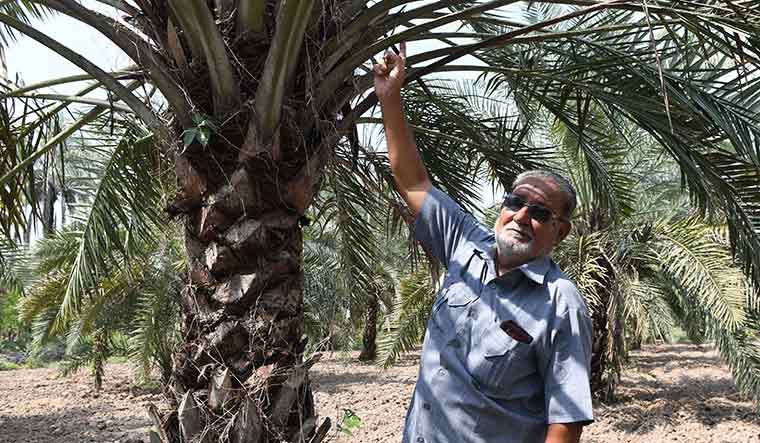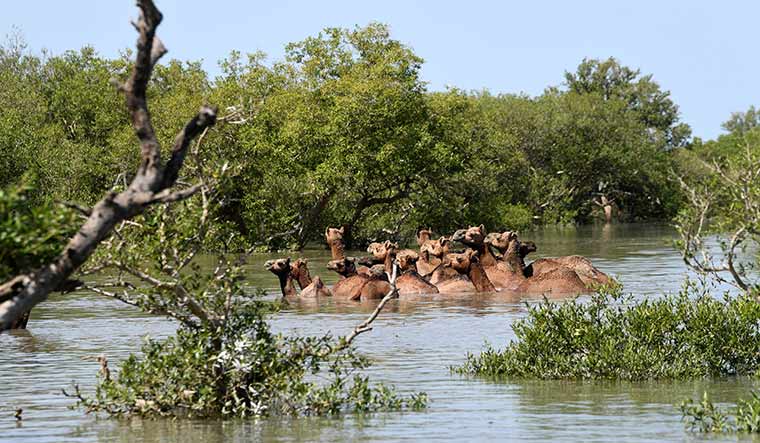MUNDRA LIVES UP to its reputation of being an old coastal town. Dusty roads clear up occasionally to reveal an imposing clock tower, and at some distance away, the town’s decaying fort walls and gateway give away the age of the place. Mundra had a revival of sorts recently. The 17th-century town used to be a municipality, but a dwindling population brought it down to a nagar panchayat and eventually to a gram panchayat. Thanks to industrial activity in the last two decades, it is back to being a municipality today.
Mundra has become synonymous with its port. In 2006, the Gujarat government divested its stake in the port, making it an entirely private entity. The Mundra Port is the country’s largest private commercial port―run by Adani Ports and Special Economic Zone Ltd―and is spread across 8,400 hectares. The development of the port and its allied industry took place during the BJP rule in the state, and party supporters cite it as a glorious achievement as it led to employment opportunities.
The people of Mundra and the Adani Group, owned by the richest man in Asia, Gautam Shantilal Adani, are inseparable, socially and economically. And, that bond is visible in the ‘Turkish’ village of Dhrub. The Turk connection is hard to miss here. It lends itself to names―of mosques, like the Turk Shahi Masjid, or medical stores, and of people―and blends in effortlessly. Ninety-five per cent of the residents here trace their ancestry to Turkey and most of them have stayed true to the traditional occupation of date cultivation.
An approach road, lined with date palms, leads to the house of Hussain Dawood Turk, a village elder. He owns 800 date palms. Dawood lives in a traditional house with two smaller rooms running parallel to the main hall, with a closed and open kitchen on the outside. “I have seen the same style of construction in Turkey,” said Dawood, one of the few villagers to visit the land of his ancestors. He added that the Turks migrated to Kutch 450 years ago. The Turks, adept at firing cannons and handling weapons, were brought in by the local king to ward off pirates, he said.
Not just his past, Dawood is equally proud of his present. He takes out his phone, scrolls through his photo gallery and shows a couple of pictures. “That’s me and Gautam Adani,” he said, proudly. “He invited me to a party recently, and I gifted him a box of dates. He is a simple man.” Dawood claims to know Adani since he took over the port in the 1990s. The port and the affiliated businesses here seem to have touched the life of each of the 2,000 residents and created goodwill for Adani. In the last few years, land rates have shot up from Rs50 lakh to Rs1.5 crore per acre.
“There are only gains because of the port and the industries,” said Dawood’s son Turk Mahmad Asharaf, who used to work as a security personnel in one of Adani’s business firms. He now works as a taxation and labour law consultant. “The locals have started benefitting after realising that they have to work as per the opportunities or else they will be left out,” he said.
Mundra has a large Muslim population, and Asharaf said half of them would vote for the BJP in the upcoming elections. “Now, there is a huge migrant population here, too,” he said. “The only flip side is that the culture is getting diluted.”
Dawood and his community take pride in their culture and the communal harmony in the village. “There has not been a single communal riot here,” said Dawood, who took us to a Shiva temple at the village’s entrance. While entering the temple’s main precinct, he removed his footwear. He was greeted by Chudamani Goswami, a relative of the priest. The cost of the temple’s upkeep is borne by the locals, said Dawood. “When the head priest died, our entire community participated in the last rites and extended every help we could,” he said. “During our weddings or celebratory events, we send raw materials for a vegetarian feast to the priest’s family. Just because they do not eat non-vegetarian food, we do not alienate them.”
This culture of communal harmony extends to another industrial belt in Kutch. Jhangi village in southern Kutch is close to the Deendayal port in Kandla. For almost 450 years, there exists a symbiotic relationship between Fakirani Jats, who are Muslims, and Rabaris, a Hindu nomadic community―forged by a unique breed of camels. The Kharai camels can swim and thrive in mangroves. Kharai means salt, and these camels have been named so because they have adapted to saltwater. There are around 4,000 Kharai camels in and around Kutch. Unlike their cousins on the mainland, this breed cannot survive without mangroves or seawater. The Rabaris own these camels, while the Fakirani Jats rear them. Male calves are sold and the profits divided between the two communities; females are reared by the Fakirani Jats.
As with Mundra, villages around Kandla port, too, are seeing a lot of industrial activity. But unlike in and around Mundra, not everyone is happy about it. More industrial activity has led to less green cover and disruption in water flow to the creeks, which, in turn, has polluted the habitat of camels and endangered their lives.
“These species are only found in Kutch and other coastal parts,” said Ramesh Bhatti, programme coordinator of Sahjeevan, an NGO working for the conservation of Kharai camels. “They have a special relationship with mangroves and the sea. Unfortunately, mangroves are getting destroyed. This has disrupted the feeding habits of camels, and we are worried they will become extinct.”
Though there is a National Green Tribunal order directing the government to ensure there is no “obstruction to estuarine water in the creeks” and no activity in the mangrove area, it has not been followed through, said Bhatti. “We demand it be declared an eco-sensitive zone,” he said. “Only such stringent measures can protect the camels.”
Malti Maheshwari, BJP MLA from Gandhidham, under which the Kandla port falls, takes pride in her government’s policies that turned the region into a “mini-India”, employing not just Gujaratis but also outsiders. The government, she said, had decided to allocate Rs6,500 crore for the development of the Kandla port, which would lead to more jobs. When asked about environmental concerns and plight of Kharai camels, she said, “We are continuously engaged in afforestation programmes to protect the environment in this area. We are also making sure that regulations are followed by industries so that the camels are not affected.”
To observe the camels in their natural habitat, we headed to Nimdivandh village in Abdasa taluk of western Kutch. The village is a staging point for local breeders of camels. Zigzagging through muddy backwaters, we reached the shore from where industries as well as mangroves were visible. A cement factory jutted out into the water, and standing before it was Noor Mohammad Mubarak, who owns 20 Kharai camels. We waited for almost four hours for the tide to rise so that we could take a speedboat to one of the islands where the camels awaited us in all their glory. Camels, too, prefer high tide as they can swim freely and not just wade. Around noon, we set off 3km into the sea, crossing mangroves and smaller islands. After a 30-minute ride, a group of camels was spotted on Hemthalbet island. The engine was turned off so as not to fluster them. Mubarak leapt into the sea and swam towards the island. He made a peculiar sound and the camels came running. Soon, Mubarak and the camels got into the water. The camels did a round of swimming, popping their heads out of the water once in a while to chomp on mangrove leaves. Mubarak usually camps on the island to tend to the camels.
“My camels can estimate the depth of water or the type of mud that is underneath them,” he said. “No other camel breed is gifted with such traits. It can also predict rain accurately. Four days before it rains, they start sweating and shift to [land] far from the water.”
Two months ago, two of Mubarak’s camels―Kharayi and Manki―died. He blames the industries for their death. “The dust from the nearby factories sticks to the leaves and pollutes the mangroves,” he said. “The camels are having trouble grazing. When two of my camels died, a well-known expert examined their bodies and told me that they had pollutants in their stomach.”
Mubarak, therefore, is wary of the ongoing industrial development. “This is one of the few habitats that the camels can survive in,” he said. “If even this is polluted completely, then there is no chance of my camels surviving.”




